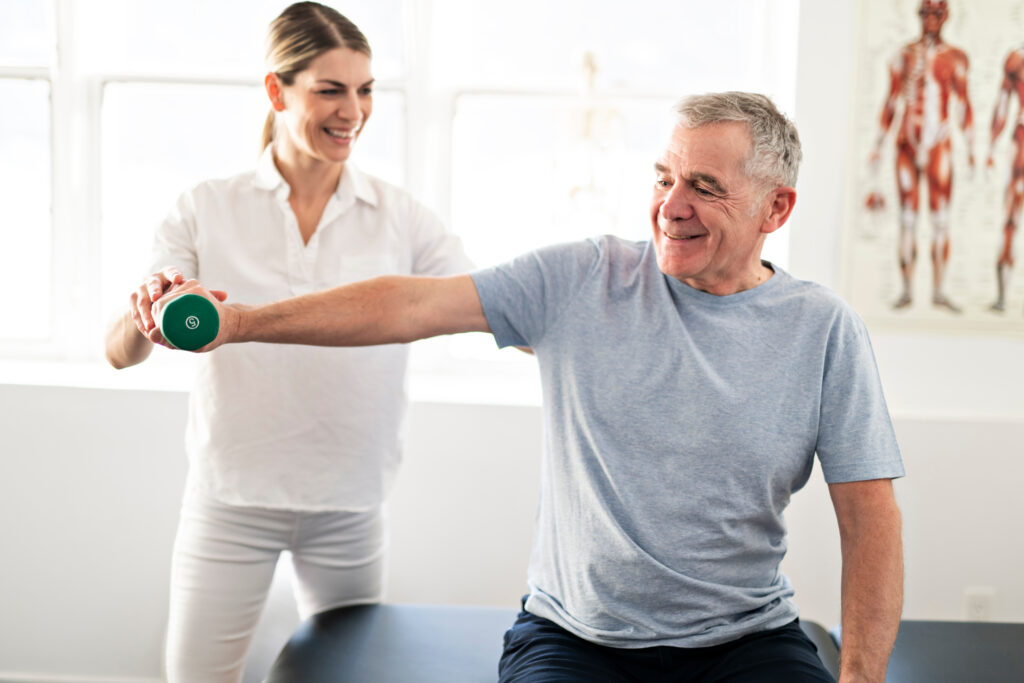
When a person with Parkinson’s disease starts losing movement, the impact can be devastating. However, new research shows that exercise can help slow the progression of symptoms.
A physical therapist can help develop an exercise program that will improve your mobility and quality of life. Ideally, physical therapy should start early in the diagnosis of Parkinson's disease.
Strengthening
While muscles weaken with age and Parkinson's disease, physical therapy helps people compensate for the loss of muscle strength. Therapists use resistance training exercises with light dumbbells, resistance bands or water-based workouts to strengthen the body's muscles.
A physical therapist may also help a patient improve their gait and walking by teaching them to make larger, exaggerated movements. This approach, called LSVT BIG (LSVT stands for Lee Silverman Voice Treatment) helps reduce hypokinesia, which causes small shuffling movements that can make it dangerous to step over an obstacle or to walk over a curb.
A physical therapist might also encourage patients to do two activities at once, such as walking while counting or bouncing a ball, to improve their balance and coordination. Studies suggest that this dual-task practice can help slow the progression of Parkinson's symptoms.
Flexibility
Whether you are in the early or advanced stages of Parkinson's disease, regular physical therapy can help you stay active and manage your symptoms. PTs will provide guidance for the best mix of exercise to boost flexibility, build muscle strength and improve balance.
Research supports a variety of workouts, including moderate aerobic training and resistance training, as well as task-specific movement training. However, a study in the journal PLoS One found that combining aerobic and resistance training had the greatest impact on improving balance and gait.
A physical therapist can also help you with dual-task practice, which focuses on performing two tasks simultaneously. This can reduce the frequency of freezing episodes, shuffling gait or falling and also help you with everyday tasks like driving and cooking.
Motor Skills
When a person’s Parkinson’s symptoms interfere with their ability to move, they can become depressed and lose confidence in their physical abilities. This can lead to a sedentary lifestyle, which exacerbates the disease and speeds up decline.
Your therapist can teach you exercises to improve your gait and balance. These may include dynamic movements, such as stepping over an obstacle or doing forward and backward walking, along with task-specific training that focuses on improving your movement patterns in specific activities.
A specialized form of exercise called LSVT BIG (LSVT stands for Lee Silverman Voice Therapy) retrains muscles to increase what is known as the amplitude of movement. As Parkinson's progresses, a person’s movements tend to shrink or take on a shuffling quality.
Research has shown that a LSVT program can reverse this trend, and your therapist can guide you through the program. He or she also can show you a variety of resistance training exercises to build strength using your body weight, bands or weights.
Balance
Having a diagnosis of Parkinson's disease is distressing and can lead to feelings of anger, frustration, sadness and depression. Sharing your feelings with family and friends, getting counseling or joining a support group can improve overall health. Getting skilled rehabilitation therapy, including physical and occupational therapy, early on can also promote your recovery.
PT can help you manage changes to movement and posture, decrease "freezing" or stiffness, and address balance issues that can increase your risk of falling. Falling is a major problem with PD, and is often associated with the loss of dopamine cells in the brain that control movement, thinking and emotions.
Your therapist can teach you exercises to improve balance, such as balance training that emphasizes what is called reciprocal movements (side-to-side or left-to-right movement patterns), stance and gait training and weight shifting activities like tai chi or dance. In addition, research supports use of "mass practice" or high repetition of exercise to stimulate neuroplasticity and slow the progression of PD symptoms.





